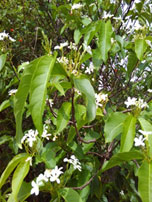SHAHEED KARTAR SINGH SARABHA AYURVEDIC MEDICAL COLLEGE & HOSPITAL
Affiliated to Guru Ravidas Ayurved University, Hoshiarpur Punjab
Affiliated to Guru Ravidas Ayurved University, Hoshiarpur Punjab

Botanical Name: Holarrhena antidysenterica (Linn.) Wall.
Family: Apocynaceae
Introduction:
This drug used in bleeding piles & G.I. tract disorders
Names in different Indian languages :
English : Easter tree,Ivory tree,Tellicherry Bark.
Hindi : kurchi
Kannada : Kodakasana
Malayalam : Kutakapala
Sanskrit : Kutaja
Tamil : Kudasappaalai-pattai,vidai (bark, seed)
Telugu : Kodisapala
Synonyms :
Kutaja, Girimallikaa, Kaalinga, Kalingaka, Indravriksha, Shakra, Vatsa, Vatsaka, Shakraahvya. Indrayava, Indrabija, Vatsabija (seed). Kurchi (bark).
Holarrhena pubescens (Buch.- Ham.) Wall. ex G. Don
Classification according to Charaka, Susrutha & Vagbhata :
Charaka :Arsoghna, Kandughna Stanyasodhana Asthäpanopaga
Susrutha : Aragvadi, Pippalyadi, Haridradi, Laksadi
Vagbhata : Aragvadi, Pippalyadi
Varieties & adulterants – (CV – controversy, AD – adulterants) :
1. W. tinctoria [CV]
2. Wrightia tomentasa [CV[
3. Salvadora oleoides – [AD]
4. Holarrhena pubescens
Morphology :
A small lactiferous, deciduous tree with woody branches.
Leaves- simple, opposite, elliptic oblong, ovate or ovate-oblong.
Flowers- in corymbose cymes, whiter fragrant.
Fruits- follicles, long, slender, parallel, , coriaceous, with long white spots.
Seeds- narrowly, oblong glabrous. Tipped at apex with spreading deciduous coma of brown hairs.
(Flowers from April-July and fruits from August-October)
Distribution & Habitat :
Common in tropical parts of India and in sub- Himalaya tract.
Chemical constituents :
pubescine, norholadiene, pubescimine, kurchinin, kurchinine, kurchinidine,holarrifine, holadiene, kurchilidine, kurchamide, kurcholessine, kurchessine, conessine, Conessidine, connessimine, conkurchine, holadiene, holarrhenine holarrhimine, kurchine, holarrhine, kurchicine, holadysine, holadysamine, holantosines A & B; kurchaline, kurchiphyllamine, holacetine etc
Properties :
Rasa Tikta, Kasäya
Virya sita (Raja Nighantu quoted it as Usna virya)
Guna Laghu, Rüksa
Vipãka Katu
Karma – Kapha-pitta hara, Grãhi, Dipana, stambana, kandughna
astringent, anthelmintic, amoebicidal, diuretic
Indication :
Rakãras, Atisãra, Grahani, Kustha, Krimi, Amavãta, Chardi, Visarpa, Vãtarakta, Jvara.
constipating, astringent, expectorant, asthma, hepatopathy, uropathy, haemorrids. diarrhea, dysentery, expectorant, gastropathy, hepatosplenomegaly, rheumatism, malaria, vomiting, skin disease etc.
Part used : Bark, leaves, seeds, flowers
Srotogamitva :
Dosha : vathahara
Dhatu :raktha
Mala :mutrala
Organ : skin, intestine
Dosage :
Powder 3-6 g decoction 50-100 ml
External use : Stem, bark and indrayava (bitter seeds) are optimum for healing of ulcers. A decoction of these helps in ulcer treatment On exuding ulcers. in cleaning indrayava is used.
Internal uses :
Digestive system : Vatashaman, deepan inhibitor of inflammation, (cures) loss of appetite, pittasarak and parasiticidal. Useful in diarrhoea and dysentery. Scientists feel that it is of great use in amoebiasis without the long term side effects of emetine. The total alkaloids of the tender pods and leaves are useful in worm infection in children. Bark is most effective in jaundice.
Circulatory system : Useful in bleeding disorders
Reproductive system: Removes muscular weakness and tones up vaginal tissues after delivery. Fevers : Antipyretic, especially in fevers of lymphatic or blood origin. Therapeutic in typhoid,
Important Yogas or Formations:Kutajãrista, Kutajãvalehya Kutaja ghrita.
Therapeutic Uses:
(1) Jvara- Decoction in Indrayava and Katukarohini is taken with rice-water (H. S.312166).
(2) Pittatisära- Seeds and bark of Kutaja are pounded with honey and Ativisa is added to it. This combination is taken with rice Water (C.S.Ci.19l5I)
(3) Kustha- Paste of Lodhra, Dhãtaki, Indravyava, Karanja and Jãti is applied externally (C.S.Ci.7195)
